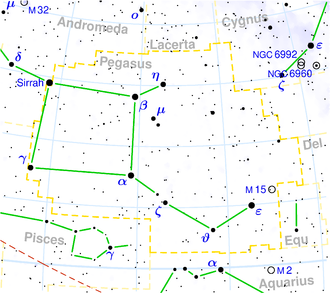NGC 7675
| Galaxy NGC 7675 |
|
|---|---|
![NGC 7675 with LEDA 1353595 (l), LEDA 71507 (ro) & LEDA 71505 (r) [1]](https://upload.wikimedia.org/wikipedia/commons/thumb/3/37/NGC7675_-_SDSS_DR14.jpg/300px-NGC7675_-_SDSS_DR14.jpg)
|
|
| NGC 7675 with LEDA 1353595 (l), LEDA 71507 (ro) & LEDA 71505 (r) | |
| AladinLite | |
| Constellation | Pegasus |
|
Position equinox : J2000.0 , epoch : J2000.0 |
|
| Right ascension | 23 h 28 m 05.9 s |
| declination | + 08 ° 46 ′ 07 ″ |
| Appearance | |
| Morphological type | E2 / HII |
| Brightness (visual) | 15.2 mag |
| Brightness (B-band) | 16.2 mag |
| Angular expansion | 0.6 ′ × 0.4 ′ |
| Position angle | 25 ° |
| Surface brightness | 13.7 mag / arcmin² |
| Physical data | |
| Affiliation | HCG 96 WBL 716 |
| Redshift | 0.028740 ± 0.000140 |
| Radial velocity | (8616 ± 42) km / s |
|
Stroke distance v rad / H 0 |
(391 ± 27) x 10 6 ly (120.0 ± 8.4) Mpc |
| history | |
| discovery | John Herschel |
| Discovery date | August 16, 1830 |
| Catalog names | |
| NGC 7675 • UGC 12608 N02 • PGC 71518 • CGCG 406-114 • MCG + 01-59-083 • 2MASX J23280594 + 0846073 • HCG 96B • GALEX ASC J232805.89 + 084607.0 • USGC U847 NED02 | |
NGC 7675 is an elliptical galaxy with extensive star formation regions of the Hubble type E / SB0 in the constellation Pegasus in the northern sky . It is estimated to be 391 million light years from the Milky Way and about 70,000 light years in diameter. Together with NGC 7674 , PGC 71505 and PGC 71507 , it forms the galaxy quartet HCG 96 .
The object was discovered by John Herschel on August 16, 1830 .
